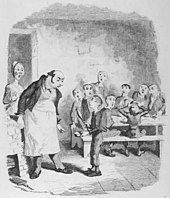Gruel
| Type | Porridge |
|---|---|
| Main ingredients | Cerealmeal or flour,waterormilk |
| Variations | Congee |
Gruelis a food consisting of some type ofcereal—such as groundoats,wheat,rye,orrice—heated or boiled inwaterormilk.It is a thinner version ofporridgethat may be more often drunk rather than eaten. Historically, gruel has been astapleof the Western diet, especially forpeasants.Gruel may also be made frommillet,hemp,barley,or, in hard times, fromchestnutflour or even the less bitteracornsof someoaks.Gruel has historically been associated with feeding thesick[1]and recently-weanedchildren.
Gruelis also a colloquial expression for any watery food of unknown character, e.g.,pea soup.[2][3]Gruel has often been associated with poverty, with negative associations attached to the term inpopular culture,as in theCharles DickensnovelsOliver TwistandA Christmas Carol.
History
[edit]Gruel predates the earliest civilizations, emerging inhunter-gatherersocieties as a meal of gathered grains soaked in water. For these societies, the application of water and especially heat to grain improved its digestibility and nutritional content, and sanitized the mixture. This gruel also presented a viable medium foryeastto develop and ferment, serving as an important precursor for bothbreadandbeer.[4]
Gruel was thestaple foodof theancient Greeks,for whom roastedmeatswere the extraordinary feast that followed sacrifice, even amongheroes,and "in practice,breadwas a luxury eaten only in towns ". Romanplebeians"ate the staple gruel of classical times, supplemented by oil, the humblervegetables,and saltfish"[5]for gruel could be prepared without access to thecommunal ovensin whichbreadwas baked. In the Middle Ages, the peasant could avoid thetitheexacted by paying in grain ground by themillerof the landowner's mill. When eaten by the peasant, the process was to roast the grains to make them digestible and grind small portions in amortarat home. In lieu of cooking the resulting paste on the hearthstone, it could be simmered in a cauldron with water or, luxuriously, with milk.
In theUnited Kingdom,it was a common remedy for the sick, relatively nourishing and easy to digest, and a standard component of the evening meal in British hospitals into the early 20th century.[6][7]
In theAmericas,maizegruels were once one of the main food sources for many Mesoamerican peoples, such as theMayaandAztecs.Atoleis a preparation of ground maize often flavored withchiliand salt (for a savory dish), or, in more modern times, withpiloncilloandcinnamon(for a sweet dish). It can be consumed as an important calorie source as a thicker meal, or as a liquid drink.
Gruel was on thethird-class menu of theTitanicon the eve of hersinking in April 1912.[8]

Variations
[edit]In many Spanish-speaking countries, several gruels are made; themasa-based drink or spoonable food calledatoleor atol de elote is a staple throughout Central America, served hot. It can range in consistency from a thin cloudy drink to a thicker porridge-like food.Horchatais a chilled sweetened drink of similar nature to thin atole. It is made from ground nutmeats or seeds, grains (often rice) and seasonings such asvanillaandcinnamon,served over ice.
Rice gruels eaten throughout Asia are normally referred to in English asporridgeas opposed to gruel. Common forms includecongee,from theTamilword for the food and most common inChina,Japaneseokayu,Koreanjuk,Filipinogoto, andVietnamesecháo. Asian porridges/gruels are typically savory[citation needed],with meat or vegetables added and stock sometimes used as the liquid cooking element.
Etymology
[edit]TheOxford English Dictionarygives an etymology ofMiddle Englishgruelfrom the same word inOld French,both of them deriving from a source inLate Latin:grutellum,adiminutive,as the form of the word demonstrates, possibly from anOld Frankish*grūt,surmised on the basis of a modern cognategrout.In modern Dutch, the plural word "grutten" still refers to de-husked, coarse ground grain and a traditional dish based on pearlbarley and blackberry is calledwatergruwel.
The Old Norse wordgrautr,meaning "coarse-ground grain", gives way to the Icelandicgrautur,Faroesegreytur,Norwegiangrøt(nynorskgraut), Danishgrød,and the Swedish and Elfdaliangröt,all meaningporridge,of which gruel is a subtype.
The German "Grießmehl", ground grain, and Dutch "griesmeel", are compounded cognates to the Englishgristandmeal.
In fiction
[edit]
In theEnglish-speaking world, gruel is remembered as the food of the childworkhouseinmates inCharles Dickens'sIndustrial RevolutionnovelOliver Twist(1838); the workhouse was supplied with "an unlimited supply of water" and "small quantities ofoatmeal".[9]When Oliver asks the master of the workhouse for some more, he is struck a blow on the head for doing so. The "small saucepan of gruel" waiting uponEbenezer Scrooge's hob in Dickens's 1843 novelA Christmas Carolemphasizes howmiserlyScrooge is. Gruel is also Mr. Woodhouse's preferred and offered dish in Jane Austen'sEmma(1816), often to comic or sympathetic effect. References to gruel in popular culture today continue to refer to miserly or starvation conditions, such asGemma CollinsinCelebrity Big Brother 17(2016), who was denied food for gruel.[10]
References
[edit]- ^A gruel ofcornmeal,soaked and cooking in a double-boiler, was recommended fortyphuspatients inThe American Journal of Nursing14.4 (January 1914) p. 296.
- ^The wordsoupis related tosop,the slice of bread which was soaked in broth or thin gruel.
- ^Maguelonne Toussaint-Samat, Anthea Bell, tr.The History of Food,revised ed. 2009, p. 161.
- ^Sinclair, Thomas R.; Sinclair, Carol Janas (2010).Bread, Beer and the Seeds of Change: Agriculture’s Imprint on World History.Cambridge, MA:CAB International.pp. 26–30.ISBN978-1-84593-705-8.
- ^Toussaint-Samat 2009, p. 93.
- ^Edmund Adolphus Kirby (1883).A pharmacopœia of selected remedies.Oxford University. p. 107.
- ^May Byron (1934).Simple Fare for Sick Folk: recipes for feeding invalids & convalescents.Hodder & Stoughton.
- ^Shoup, Kate (2017-12-15).Life as a Passenger on the Titanic.Cavendish Square Publishing, LLC.ISBN978-1-5026-3043-8.
- ^Oliver Twist,chapter 2.
- ^There have been many parodies ofOliver Twist;for instance, inThe Simpsonsepisode "Kamp Krusty",Bart and some of the other children are forced to eat"KrustyBrand Imitation Gruel "as their only meal, punctuated by the comment" Nine out of tenorphanscan't tell the difference. "
